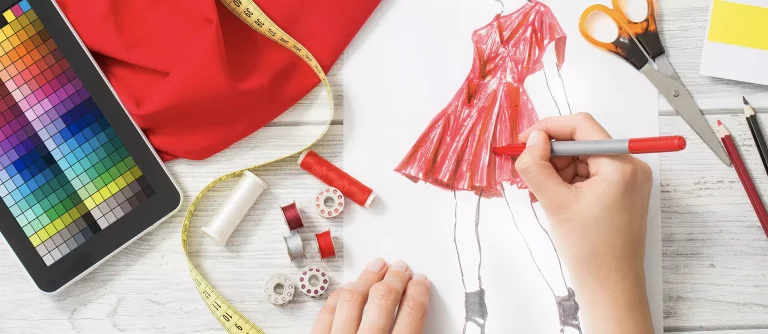How to Become an Interior Designer
Creative people love channeling their talents into their careers or making careers of their talents entirely. If you’re an artist, the scary part about that is all the information out there telling you that you’ll never succeed in art, and you should pursue more practical career paths.
You don’t need to give up on your dreams. If you’ve got a knack for putting spaces together in a way that combines function with aesthetics pleasingly, then you might consider using your talents as an interior designer.
What is an Interior Designer?
Interior design means developing layouts for rooms, offices, studios, restaurants, and more. As an interior designer, you’ll work with clients requiring designs for both residential and professional spaces.
While most people use the terms “interior design” and “interior decorating” interchangeably, they’re two distinct professions. Designers can and do decorate as part of their jobs. However, decorators can’t design.
Decorators decide on color palettes, textures, furniture, and lighting for spaces. Designers do all this in addition to planning out the space so it properly serves its functions.
What Does a Typical Workday for an Interior Designer Look Like?
Interior designers normally spend their days sketching layouts, developing and establishing project timelines, and calculating costs. They make decisions regarding the overall space, the materials the client needs, and even color palettes and furniture styles.
Most experienced designers manage about 20 to 30 projects at any given time. Generally, they attend team meetings early in the day to lay out what’s happening and then visit project sites to check in personally with clients and meet with the builders and contractors.
They spend most of the rest of their days working on sketches and proposals while continuing to communicate with clients.
If that sounds super busy, it is. However, interior designers can, and often do, maintain an eight to nine-hour workday, though some will work 12 hours or longer.
The best news is that you’ll never find yourself bored at work, especially once you’ve established yourself and your portfolio. If you’ve ever had a job where you spent a lot of your workday searching for the end of the Internet, you know how tedious that can be. As an interior designer, you probably won’t have time for that.
Will I like Being an Interior Designer?
Like every profession, interior design has its negatives. However, if you love using your creativity every day, working with people, and staying busy, then you’ll probably enjoy being an interior designer very much.
Characteristics and Skills of a Good Interior Designer
An interior designer needs to have excellent visual-spatial skills to help their clients visualize a space before work begins. Remember, you’ll be going into empty shells and painting a picture for your client before work even begins. You should be able to put across your vision to your clients clearly.
Good designers have a knack for collaboration and teamwork. You have to hear a client’s desires and translate that into what they want for their particular space. As such, you need excellent written and verbal communication skills so you, your clients, and your team (if you work with one) can pull projects together smoothly.
Leadership skills are necessary as well. You might find yourself in charge of your team on a project, or, if you’re self-employed, leading the project on which you’re working. That can include steering discussions and decision-making and mediating disputes when necessary.
Since all of this includes knowledge and discussion of things like building and safety codes that might preclude something a client wants, every one of these interpersonal skills is absolutely necessary.
Finally, you must have excellent time-management and multitasking skills. You’ll have several projects to work on at once and deadlines all over the place. To ensure you meet all your obligations without getting overwhelmed, you have to manage your workload efficiently and effectively.
Why You Might Not like Being an Interior Designer
If you’re an introvert, you definitely won’t like having a career as an interior designer. There’s too much work with other people, which could stress you out. The same is true if you have trouble in leadership positions, even informal ones.
If you don’t know how to carve time out of your day for yourself, before, after, and during, you probably won’t enjoy your job very much.
Typical Schooling for a Successful Interior Designer
Like many professions, to become an interior designer, you have several levels of education and certification you should obtain before you begin work. Some of it is basic education in your field, just like any undergraduate college degree.
But you also require certain certifications because you’re dealing with things involving health, safety, laws, building codes, and other ordinances.
Degree Type
Not every job in interior design requires a degree. However, you’ll do much better if you get one. You can get an associate’s, bachelor’s, or master’s degree, ideally from a school that the Council for Interior Design Accreditation (CIDA) has certified (although this isn’t a requirement; a school with formal accreditation from a nationally recognized accrediting body will suffice).
Over 25 states require interior designers to have a license to work. You’ll find it much easier to obtain your licenses and certifications if you first earn a degree in interior design. Whether you go for an associate’s, bachelor’s, or master’s, depends entirely on what career path you want.
Keep in mind that only bachelor’s and master’s degrees are professional degrees. While an associate’s degree is easier and cheaper to earn, you have to have more work experience to become eligible to sit for exams, which can limit your career options.
You may also limit your internship opportunities if you go for an associate’s degree. However, such a degree can help you get your foot in the industry’s door, which may make getting a four-year degree easier.
Classes
You’ll have many classes to take to earn your degree, not including whatever general education requirements there are. These classes include, but aren’t limited to, the following:
- Intro to Interior Design
- Elements of Design
- Design Philosophy
- Drawing and Composition
- Quick Sketching for Interiors
- Measuring and Drafting
- Spatial Organization
- Drawing Floor Plans
- Color Theory and Application
- Rendering and Perspective
- Computer-aided Design
- Textiles
- Materials and Applications
- Fabrics and Furniture Styles
- Wall and Floor Treatments
- Lighting Design
- Building Codes and Standards
- Special Needs Design
- Material Sourcing and Specification
- Sustainable Building Design
- Business Practices and Ethics
- Portfolio Creation and Presentation
- Design Showroom Protocols and Procedures
- History of Built Environment
- Design Trends and History
- Environmental Studies
- Cultural Anthropology
You might also have more architectural classes, drawing classes, and other art classes, depending on the school to which you choose to go and the full program it offers.
Years of Schooling
On average, you can expect to spend a minimum of four years working on your bachelor’s degree. An associate’s degree can shave up to two years off the time it takes to earn your bachelor’s degree, but that’s still a minimum of four years.
If you’re going for your master’s degree, you’ll have an additional two years of schooling following graduation, for a total of six years of formal education.
You don’t have to earn your master’s degree to become an interior designer. If you want to own your own design firm, though, or work your way into the upper ranks at a well-known firm, you’ll want to pursue a master’s degree at some point.
Certifications
In addition to state laws, many companies require certain licenses and certifications before you can start work as a designer.
The Council for Interior Design Qualifications (CIDQ) administers an exam called the National Council for Interior Design Qualification (NCIDQ). This exam is the only nationally-recognized certification exam for interior designers.
To become eligible to take the NCIDQ exam, you must have a minimum of 60 semester credit hours or 90 quarter credit hours of interior design coursework that’s included in a bachelor’s or master’s program from an accredited institution.
If you meet that requirement, you don’t have to worry about whether you went to a school with CIDA accreditation. Nationally-recognized accreditation works just fine.
You can also qualify for the exam with a bachelor’s or master’s degree in a non-interior design major as long as you also obtain an interior design certificate.
You need roughly two years of work experience in interior design in addition to your degree and passing the exam to become an NCIDQ-qualified interior designer.
You’ll pay an application fee of up to $225 and an additional $1,110 to take all three parts of the exam simultaneously. You can split it up and take one portion with a $95 application fee and a $225 exam fee, and then take the other two portions later for a $145 application fee and a total of $810 in exam fees.
If you don’t live in a state that requires NCIDQ certification, you’ll have a stronger career path if you take the exam anyway. The exam’s purpose is to demonstrate a level of knowledge, skills, and abilities that make you qualified to work on projects of all types.
Continuing Education
Fields and industries evolve every day, making continuing education important. You need to stay on top of the latest developments in everything from technology to updated and newly-implemented laws and codes.
To prove you’re keeping up with the times, you should stick to approved courses for this part of your career.
The American Society of Interior Designers (ASID) approves various continuing education courses through colleges and independent study. Any continuing education courses that your state regulatory board officially approves is acceptable to ASID as a continuing education course.
Also, ASID accepts certain interior design classes from colleges and universities that carry CIDA accreditation (you can’t put these courses towards a degree, though). Any education that the following organizations officially approve is acceptable as well:
- American Institute of Architects
- Green Building Certification Institute
- International Facility Management Association
- National Kitchen and Bath Association
The courses you take and when you take them depend on your work (if you’re self-employed) or on the firm you work for. Companies often send their employees through continuing education courses when new information, methods, technology, and more become available for widespread use.
The bottom line here is that you’ll need to stay on top of advances in your field with continuing education. How you do that depends on your particular situation.
Best Colleges for Interior Design
Who has the best interior design schools? If you can get into the country’s top programs, you add to your prestige when you enter the field.
You don’t need to pack up and move to go to interior design school in today’s world. You do have online options in addition to brick-and-mortar options.
3 Best In-Person Interior Design Schools
We’ve done extensive research to find the top three in-person interior design schools in the country.
Savannah College of Art and Design, Savannah, Georgia
The Savannah College of Art and Design frequently appears among the top design schools in the U.S. and worldwide. Its entire curriculum focuses on things like color theory, modern architectural design, visual culture, and more.
Students complete 180 credits and go through six studio courses, too, with the final two serving as their capstone courses. Besides that and the above, students also learn practical skills, including mock interviews, portfolio development, and other aspects of professional development.
You’ll pay quite a bit to go there, though, even if you attend one of the satellite campuses in Atlanta or Hong Kong. SCAD costs between $35,000 and $40,000.
New York School of Interior Design, New York City, New York
The New York School of Interior Design is exactly what it sounds like: A school focused entirely on interior design. You must complete 132 credits’ worth of education there, with a curriculum that blends liberal arts with interior design’s professional aspects.
You get courses in everything from kitchen design to architectural workshops and learn much of the legal, technical, and business aspects of the job. Perhaps most interesting is that students must also complete intensive work in either French or Italian and defend a thesis to graduate.
If you’d like to go to NYSID, you’ll pay between $35,000 and $40,000 for the full program.
Parsons School of Design, New York City, New York
One of the oldest design schools in the country, the Parsons School of Design in New York calls interior design an “intellectually rigorous creative force in everyday life.” Students at Parsons work very closely with faculty and outside professionals to build a solid foundation for an interior designing career.
Students study everything from art history to materiality, hand drawings, renderings, and even three-dimensional modeling. You’ll complete 120 credits, but can transfer up to 60 credits from another school.
Of our three favorite schools, Parsons is the cheapest, costing between $25,000 and $30,000 total.
3 Best Online Interior Design Schools
If you would prefer not to go to a brick-and-mortar school, you can study interior design online. The only catch is that the schools you choose must have proper accreditation. Your best bet is to find a CIDA-accredited online school.
Academy of Art University, San Francisco, California
The Academy of Art University offers an online program for a Bachelor of Fine Arts degree in interior design. CIDA-accredited, you’ll learn everything you’d learn in a standard classroom right from the comfort of your home.
If you choose to pursue a master’s degree, you can continue your education with the Academy of Art University, as they offer that online as well. Every program offers the same instruction you’d get in a standard classroom so you won’t be left behind.
You can expect to pay about $25,000 to $30,000 to go through their full online program.
Rocky Mountain College of Art and Design, Denver, Colorado
Rocky Mountain College of Art and Design recently reorganized its program structures so that online courses correspond neatly with their in-person courses. However, that doesn’t mean you’re stuck with a hybrid schooling model. You can pursue a Bachelor of Fine Arts degree in interior design entirely online if that’s what you choose.
They offer a CIDA-accredited program that gets progressively more difficult and includes courses in space planning, lighting design, and human and environmental behavior. You’ll get one-on-one time with your instructors even though you’re online.
To go through Rocky Mountain’s online program, you’ll pay a $50 application fee and $544 per credit hour.
New York School of Interior Design, New York City, New York
NYSID offers an Associate in Applied Science in Interior Design online, so if you want to attend NYSID but don’t want to move to New York to do so, you can still obtain an associate’s degree and get your foot in the door.
Students learn the fundamentals of drawing, drafting, color theory, visual concepts, and more. You can take your classes full-time or part-time, and this degree satisfies the requirements for the first two years of your bachelor’s degree.
Because NYSID is a prestigious art school, whether you take classes online or in person, you’ll pay $1,060 per credit for an AAS in Interior Design, in addition to application and enrollment fees.
Can I Skip College and Teach Myself How to Be an Interior Designer Without a Degree?
Yes, you can, assuming you already have the basic skills necessary for interior design. Here are three non-traditional paths to becoming an interior designer.
Find and Follow Designers with Instructional YouTube Videos
YouTube isn’t a school, but you can learn a lot from videos when you find the right people. Those who know how to break things down the way a good college instructor does can help you develop and hone your skills, and give you the boost you need to get into interior design.
The same is true of other social media influencers who are designers.
Look for an Internship That Doesn’t Require Schooling
Some interior design firms offer internships to people who aren’t pursuing degrees. You can also find self-employed designers and ask about interning or assisting them with their work.
You’ll need to demonstrate your skills, though, so start with designing small spaces for friends and family. For instance, if you have a friend who’s remodeling their bathroom, sketch some designs and work with them on the remodel. That gives you something to show off when you look for internships.
Start Your Own Business
Starting your own interior design business is a great way to break into the industry without a degree. The major catch to this is that you need first to decide what services you want to provide. Remember, many states require certain certifications and licenses. If you don’t have a degree, you have to have a certain number of work hours to qualify for those exams to get your certifications.
You can start as a decorator and work your way into design from there. Do so gradually to accumulate experience, develop a solid portfolio, and build a network of clients and contractors.
Which Software Programs Do Interior Designers Use?
The best way to make your job as an interior designer easier is to find good software to use. There are a ton of programs out there, but we recommend you try the following programs.
AutoCAD LT
AutoCAD LT is probably the most popular program for interior designers. You can draft precise two-dimensional drawings and plans and change, edit, and work your sketches from pretty much any computer. It even comes with a mobile app so you can work offline if necessary.
TurboCAD
TurboCAD is popular because you can develop 3D renderings of the spaces on which you’re working. This program is pretty much an upgrade from AutoCAD, and you do need some experience using design software to get the hang of TurboCAD. If you need a more comprehensive program than AutoCAD, TurboCAD may suit your needs well.
AutoDesk 3D Max
For designers who want full control of their digital work, AutoDesk’s 3D Max is a fantastic program. Designers and their clients get detailed images of their work as they create and edit it. It also has automated processes to help you streamline your content production and deadlines so you can manage your workflow better.
Easyhome Homestyler
This program is easy to use and allows you to digitally visualize your plans without a lot of complicated bells and whistles to navigate. You can build two- and three-dimensional floor plans with furnishings scaled to size. Easyhome Homestyler is good for those who want a basic program to learn from or augment their other work.
Live Home 3D Pro
Designers can create their two-dimensional plans and layouts and add furnishings with Live Home 3D Pro. Once you finish up your 2D plans, the program can translate them into 3D renderings. From there, you can work with everything from natural to artificial lighting, elevation views, and even walkthroughs. This program has pretty much everything a designer needs.
What Are the Best Blogs and Influencer Accounts to Follow?
Besides continuing education, one fantastic way to stay on top of trends and get inspiration is to follow designers and influencers on social media. Some of the best blogs and influencers to start following are:
- Jen Bishop for contemporary design
- Lisa Tisle for color inspiration
- Elin Kiken for minimalist design
- Freshome for luxury design
- Apartment Therapy for small-space design
- Decor Aid for timeless designs
- Apartment 34 for modern simplicity
5 Ways to Break into the Interior Design Industry
So you’ve gotten your degree and certifications, and you’re ready to set out into the world of interior design. What are some ways to break into the industry besides sending out your resume?
Get Online
Today, you can’t get anywhere if you’re not online, particularly in a creative field. You need an online presence. The best way to do that is to create a personal website with a biography and a portfolio of your best work. Some easy website builders include:
- Wix
- WordPress
- Weebly
- Squarespace
Each of these offers free options, and while those options limit what you can do, it means you can create your website without paying with money you might not have.
Get Social
A website and online portfolio are all well and good, but you also need a social media presence. At a bare minimum, you should have a professional profile on LinkedIn where you can connect with other designers who can help you out. An Instagram account showcasing work you’ve done beyond your portfolio is a good idea as well.
Twitter is another great way to leverage social media. Hashtag campaigns and photos you can share there increase your overall online exposure.
Become an Apprentice
If you already know an interior designer, especially if they have their own firm, you can ask to apprentice or intern with them. Not only do you gain a lot of practical experience, but you build your network, helping you break into the field full-time.
Continue Learning
Besides formal continuing education, you should keep up with influencers and bloggers because they’re likely to have the newest information with unique takes on it. Don’t discount them as sources of learning and inspiration.
Keep Grinding
Everybody fails, but don’t let those failures set you back, and above all, don’t let them make you give up. We don’t learn from our successes; we learn best from our mistakes and failures. Draw lessons from those and learn how to avoid the same problems in the future.
FAQs
Still have questions? We have answers to some of the most commonly asked questions about becoming an interior designer.
How Much Money Do Interior Designers Typically Make?
On average, an interior designer makes about $60,000 per year. What you personally will earn depends on your skills and the clientele you attract.
What Do You Study to Be an Interior Designer?
Your studies will include drafting, drawing, color theory, using design software, sustainable materials and textiles, environmental and anthropological studies, and more. Because interior design deals with human behavior in a given space, your education includes a wide range of topics and fields of study.
Is Interior Design a Good Career Choice?
It depends. If you’re visually creative and you love drawing, drafting, and working with people, then yes, it’s a good career choice because you can make a decent living doing what you love.
However, if you have problems working with people or have problems with time and workflow management, this may not be a good career move for you.
Are There a Lot of Job Openings for Interior Designers?
Yes, but that number is declining somewhat. The most opportunities exist in high-income areas, where people are most likely to renovate and remodel houses. There will still be commercial opportunities, including new construction, but expect those jobs to become fewer and farther between over the next ten years.
What’s the best website to find interior design job listings?
Job boards like ZipRecruiter and Simply Hired have thousands of listings for interior designers looking for work.
Also, the International Interior Design Association’s website has job listings, a place to create a profile and upload a resume, and more. If nothing else, you can use the IIDA’s website to increase your online presence.
What Are Some Big Companies That Hire Interior Designers?
- EwingCole in Philadelphia gets many high-profile projects, including commercial projects, and has eight offices outside of Philly.
- HDR is a prestigious, award-winning construction firm with more than 200 offices worldwide, and they have projects ranging from residential to industrial all over the globe.
- Moseley Architects combines construction, architecture, interior design, and more across Virginia and the Carolinas. They have projects ranging from colleges to residential spaces and restaurants.
- Perkins and Will has 2,000 employees and 23 offices worldwide. If you’re new to the field, Perkins and Will is a good place to work. In addition to their extensive portfolio, they have many resources for personal and professional growth and development.







